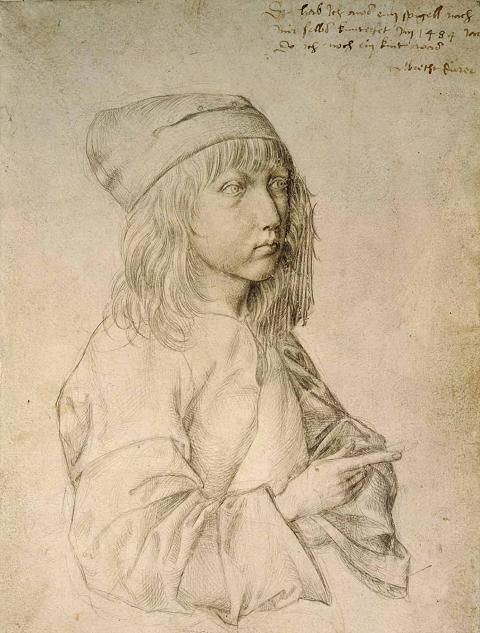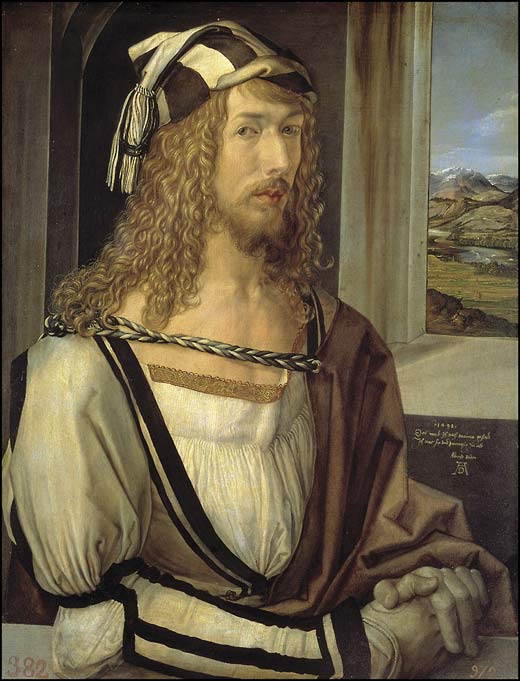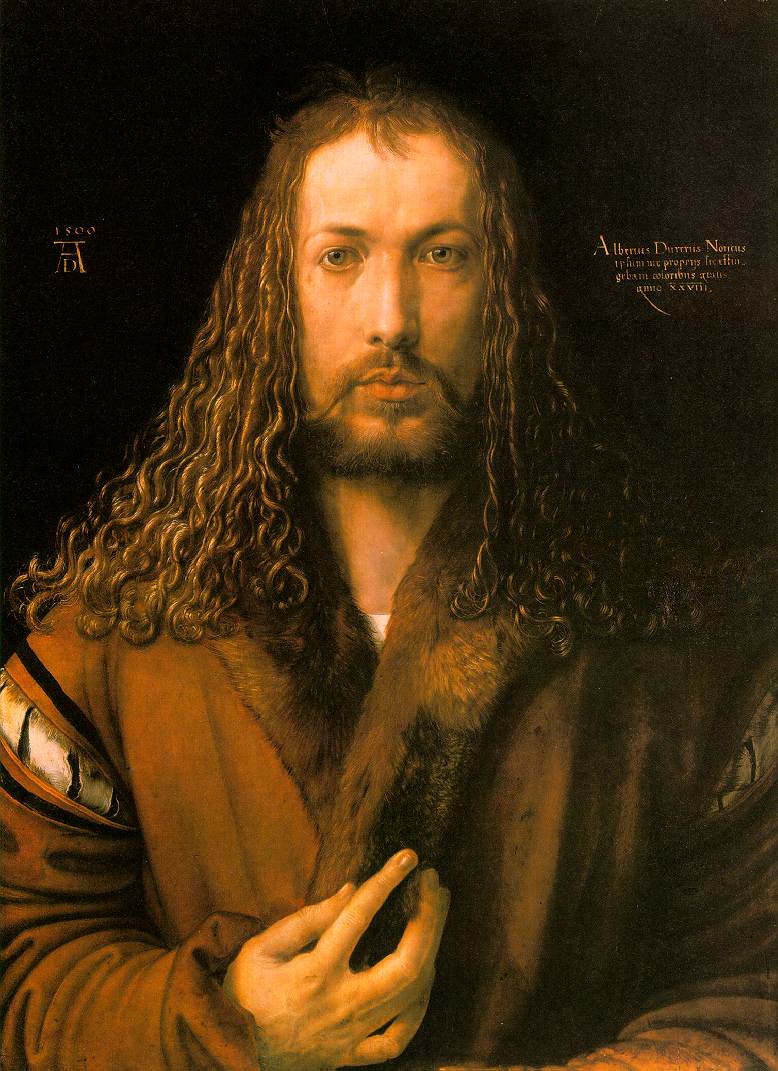Thanks to my familial connection to Nürnberg,
this collection of self portraits was particularly interesting to me!
The German artist Albrecht Dürer (1471-1528) was one of the greatest figures of the Northern Renaissance. As a draughtsman and painter, he rivaled his elder contemporary Leonardo Da Vinci, and his masterful woodcuts and engravings of mythical and allegorical scenes made him famous across Europe.
Age 13:
In the first half of his life, Dürer made a series of exquisite self-portraits. The earliest (above) was made in 1484, when the artist was a precocious boy of 13. It was drawn in silverpoint. Sometime later, he wrote in the upper right-hand corner: “This I have drawn from myself from the looking-glass, in the year 1484, when I was still a child — Albrecht Dürer.” The drawing, now in the collection of the Albertina museum in Vienna, was made at about the time Dürer became an apprentice goldsmith in his father’s jewelry shop in Nuremberg. Much to his father’s disappointment, he would leave the goldsmith shop about a year later to become an apprentice to the prominent Nuremberg artist and printmaker Michael Wolgemut. But the early experience of working with the tools in the goldsmith shop would prove invaluable to Dürer’s later work as an engraver.
Age 22:
After Dürer finished his apprenticeship with Wolegmut at the age of 19, he followed the tradition of young artists and embarked on a guild tour of southern Germany to study the work of various artists and printmakers. He was probably in Strasbourg when he painted his “Portrait of the Artist holding a Thistle” (above) in 1493. He was 22 years old. The portrait was painted in oil on vellum, and was pasted on canvas several centuries later. Johann Wofgang von Goethe saw the painting in 1805 at a museum in Leipzig and was deeply impressed. In 1922 it was purchased by the Louvre.
“The face still has some of the childish features seen in his early drawing of a Self-Portrait,” says the Louvre Web site, “but the manly neck, the strong nose, and the vigorous hands are already those of an adult. Dürer, who was also an excellent engraver, composed his works in a very graphic fashion. The almost metallic fineness of detail, seen in the prickles of the thistle, also recalls his early training as a goldsmith.”
There are two competing theories about the meaning of the painting. Some scholars believe it was an engagement present for Agnes Frey, whom Dürer would marry the following year. “In fact,” says the Louvre, “the thistle held by the artist is called ‘Mannstreu’ in German, which also means ‘husband’s fidelity.’ This pledge of love would also explain the elegance of the costume. The main loophole in this hypothesis is that Dürer may still have been unaware of the marriage, which had been arranged by his father.” A rival theory is that the thistle represents the crown of thorns from Christ’s Passion. In any case, the artist’s inscription reads, “Things happen to me as it is written on high.”
Age 26:
The second of Dürer’s three painted self-portraits was made in 1498, when he was 26 years old and entering his mature period as a master artist. Dürer had made his first of two visits to northern Italy a few years earlier to study Italian art and mathematics. While there, he was impressed and gratified by the elevated social status granted to great artists. In Germany he had been looked down upon as a lowly craftsman. “How I shall freeze after this sun!” Dürer wrote home to his friend Willibald Pirckheimer from Italy. “Here I am a gentleman, at home only a parasite.” Upon his return to Nuremberg, Dürer asserted his new sense of social position. In the portrait above he depicts himself as something of a dandy, with flamboyant dress and a haughty bearing. The painting was made in oil on a wood panel, and now resides in the Museo del Prado in Madrid.
Age 28:
The Christ-like self-portrait above was painted in 1500, shortly before Dürer’s 29th birthday. The painting was made in oil on a wooden panel, and is now in the collection of the Alte Pinakothek in Munich. Unlike his earlier self-portraits, which were composed in the customary three-quarters view, Dürer’s self-portrait of 1500 depicts the artist faced squarely toward the viewer — a pose usually reserved at that time for images of Christ. His hand, touching the fur collar of his coat, brings to mind the gestures of blessing in religious icons. The highly symmetric composition draws attention to the eyes, which gaze directly at the viewer. The artist’s monogram, “AD,” and the Latin inscription — “I, Albrecht Dürer of Nuremberg, portrayed myself in everlasting colors aged twenty-eight years” — are placed at eye-level to strengthen the effect. The year “1500″ is written directly above the monogram, giving the “AD” a second meaning as Anno Domini, which further reinforces the connection between Dürer and Christ. The art historian Joseph Koerner has suggested that the entire composition, from the triangular outline of the frontal likeness to the curve of Dürer’s fingers, echoes the overarching “A” and nestled “D” of the artist’s monogram. “Nothing we see in a Dürer is not Dürer’s,” writes Koerner, “monogram or not.”
via {open culture}
Subscribe to:
Post Comments (Atom)





0 comments:
Post a Comment